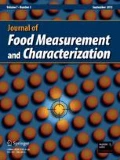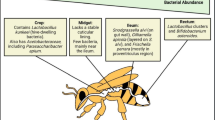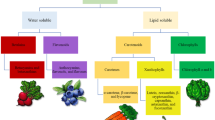Abstract
Honey, because of its nutritional and medicinal values, is in high demand and has become one of the important commodities. However, the issue of its quality and authenticity remain as important factors in consumption and marketing of honey. To assess the possibility of discriminating honeys by their geographical and botanical origins; 30 fresh honey samples of different botanical and geographical origins were collected and their major physico-chemical properties such as: total dissolved sugar (TDS), total ash, sugar profile, acidity, metallic ions and electric conductivity (EC) were investigated. The data was subjected to different chemo-metric (Hierarchical Cluster, Principal components and stepwise discriminant) analysis. Among the 23 characters used in the analysis; only 11 (TDS, EC, acidity, total ash, colour, and some specific metallic ions) characters have showed significant variations among different origin honeys. According to the stepwise discriminant analysis; 11 variables confirmed the grouping of the honey samples into four cluster groups based on their botanical and geographical origins. The clustering of the honeys associated with dominant plant source & climatic conditions of their origins. The study generally revealed the successful discrimination of honeys into their botanical and geographical provenances using fewer physico-chemical characters supported with melissopalynological data through applying suitable chemo-metric analysis.





Similar content being viewed by others
References
P.C. Molan, A. Mizrahi, Y. Lensky, Honey as an antimicrobial agent. In A. Mizrahi & Y. Lensky (eds.), Bee products: properties, applications and apitherapy. (Plenum Press, New York, 1997), pp. 27–37 http://www.springer.com/gp/book/9780306455025
O.M. Herna´ndez, J.M.G. Fraga, A.I. Jime´nez, F. Jime´nez, J.J. Arias, Characterization of honey from the Canary Islands: determination of the mineral content by atomic absorption spectrophotometry. Food Chem. 93, 449–458 (2004). doi:10.1016/j.foodchem.2004.10.036
J.F. Cotte, H. Casabianca, J. Lhéritier, C. Perrucchietti, C. Sanglar, H. Waton, Study and validity of 13C stable carbon isotopic ratio analysis by mass spectrometry and 2 H site-specific natural isotopic fractionation by nuclear magnetic resonance isotopic measurements to characterize and control the authenticity of honey. Anal. Chim. Acta. 582, 125–136, http://www.sciencedirect.com/science/journal/00032670/582/1 (2007)
J. Wang, Q.X. Li, Chemical composition, characterization, and differentiation of honey botanical and geographical origins. Adv. Food Nutr. Res. 62, 89–137 (2011). doi:10.1016/B978-0-12-385989-1.00003-X
E. Alissandrakis, P.A. Tarantilis, P.C. Harizanis, M. Polissiou, Comparison of the volatile composition in thyme honeys from several origins in Greece. J. Agric. Food Chem. 55, 8152–8157 (2007). doi:10.1021/jf071442y
S. Serrano, M. Villarejo, R. Espejo, M. Jodral, Chemical and physical parameters of Andalusian honey: classification of citrus and eucalyptus honeys by discriminant analysis. Food Chem. 87, 619–625 (2004). 10.1016/j.foodchem.2004.01.031
O. L. Persano, M.G. Piazza, A.G. Sabatini, M. Accorti, Characterization of unifloral honeys. Apidologie 26, 453–465 (1995), https://hal.archives-ouvertes.fr/hal-00891311
P. Przybylowski, A. Wilczynska, Honey as an environmental marker. Food Chem. 74, 289–291 (2001). doi:10.1016/S0308-8146(01)00153-4
European Union, Council Directive 2001/EC relating to honey. Off. J. Eur. Communities L 10, 47–52 (2001), http://faolex.fao.org/docs/pdf/eur37441.pdf
M.V. Baroni, C. Arrua, M.L. Nores, P. Fayé, M.P. Díaz, G.A. Chiabrando, D.A. Wunderlin, Composition of honey from Córdoba (Argentina): assessment of North/South provenance by chemometrics. Food Chem 114, 727–733 (2009). doi:10.1016/j.foodchem.2008.10.018
E. Corbella, D. Cozzolino, Classification of the floral origin of Uruguayan honeys by chemical and physical characteristics combined with chemometrics. LWT 39, 534–539 (2006). doi:10.1016/j.lwt.2005.03.011
O.A. Naab, M.A. Tamame, M.A. Caccavari, Palynological and physicochemical characteristics of three unifloral honey types from central Argentina. Span. J. Agric. Res. 6, 566–576 (2008)
C. Cimpoiu, A. Hosu, V. Miclaus, A. Puscas, Determination of the floral origin of some Romanian honeys on the basis of physical and biochemical properties. Spectrochim. Acta. A. 100, 149–154 (2013). doi:10.1016/j.saa.2012.04.008
G. Montenegro, M. Gómez, G. Casaubon, A. Belancic, A.M. Mujica, R.C. Peña, Analysis of volatile compounds in three unifloral native Chilean honeys. Int. J. Exp. Bot. 78, 61–65 (2009)
C.E. Manyi-Loh, R.N. Ndip, A.M. Clarke, Volatile compounds in honey: a review on their involvement in aroma, botanical origin determination and potential biomedical activities. Int. J. Mol. Sci. 12, 9514–9532 (2011). doi:10.3390/ijms12129514
M. Juan-Borrás, E. Domenech, M. Hellebrandova, I. Escriche, Effect of country origin on physicochemical, sugar and volatile composition of acacia, sunflower and tilia honeys. Food Res. Int. 60, 86–94, http://hdl.handle.net/10251/59309 (2014)
I. Escriche, M. Kadar, M. Juan-Borrás, E. Domenech, Suitability of antioxidant capacity, flavonoids and phenolic acids for floral authentication of honey. Impact of industrial thermal treatment. Food Chem. 142, 135–143 (2014). doi:10.1016/j.foodchem.2013.07.033
I. Sergiel, P. Pohl, M. Biesaga, A. Mironczyk, Suitability of three-dimensional synchronous fluorescence spectroscopy for fingerprint analysis of honey samples with reference to their phenolic profiles. Food Chem. 145, 319–326 (2014)
G.A. Nayik, V. Nanda, Characterization of the volatile profile of unifloral honey from Kashmir valley of India by using solid-phase microextraction and gas chromatography–mass spectrometry. Eur. Food Res. Technol. 240, 1091–1100 (2015). doi:10.1007/s00217-015-2413-2
F.A. Tomás-Barberán, I Martos, F. Ferreres, B.S. Radovic, E. Anklam, HPLC flavonoid profiles as markers for the botanical origin of European unifloral honeys. J. Sci. Food Agric. 81, 485–496 (2001). doi:10.1002/jsfa.836
L. Yaoa, N. Dattaa, F.A. Toma´s-Barbera´nb, F. Ferreresb, I. Martosb, R. Singanusongc, v Flavonoids, phenolic acids and abscisic acid in Australian and New Zealand Leptospermum honeys. Food Chem. 81, 159–168 (2003)
L. Yao, Y. Jiang, R. Singanusong, N. Datta, K. Raymont, Phenolic acids and abscisic acid in Australian Eucalyptus honeys and their potential for floral authentication. Food Chem. 86, 169–177 (2004). 10.1016/j.foodchem.2003.08.013
L. Yaoa, Y. Jiang, R. Singanusong, N. Datta, K. Raymont, Phenolic acids in Australian Melaleuca, Guioa, Lophostemon, Banksia and Helianthus honeys and their potential for floral authentication. Food Res. Int. 38, 651–658 (2005). doi:10.1016/j.foodres.2005.01.002
G.A. Nayik, B.N. Dar, V. Nanda, Physico-chemical, rheological and sugar profile of different unifloral honeys from Kashmir valley of India. Arab. J. Chem. (2016). doi:10.1016/j.arabjc.2015.08.017
C. Chalhoub, P. Gotsiou, N. Lydakis-Simantiris, P. Kefalas, Novel quality control methods in conjunction with chemometrics (multivariate analysis) for detecting honey authentication. Crit. Rev. Food Sci. Nutr. 45, 193–203 (2005). doi:10.1080/10408690590956369
C.H. Latorre, R.M.P. Crecente, S.G. Martín, J.B. García, A fast chemometric procedure based on NIR data for authentication of honey with protected geographical indication. Food Chem. 141, 3559–3565 (2013). doi:10.1016/j.foodchem.2013.06.022
G.A. Nayik, V. Nanda, Physico-chemical, enzymatic, mineral and colour characterization of three different varieties of honeys from Kashmir valley of India with a multivariate approach. Pol. J. Food Nutr. Sci. 65, 101–108 (2015). doi:10.1515/pjfns-2015-0022
G.A. Nayik, V. Nanda, A chemometric approach to evaluate the phenolic compounds, antioxidant activity and mineral content of different uni-floral honey types from Kashmir, India. LWT—Food Sci. Technol. 74, 504–513 (2016). doi:10.1016/j.lwt.2016.08.016
E. Anklam, A review of the analytical methods to determine the geographical and botanical origin of honey. Food Chem. 63, 549–562 (1998). doi:10.1016/S0308-8146(98)00057-0
S. Ouchemoukh, H. Louaileche, P. Schweitzer, Physicochemical characteristics and pollen spectrum of some Algerian honeys. Food Control 18, 52–58 (2007). doi:10.1016/j.foodcont.2005.08.007
G. Downey, K. Hussey, J.D. Kelly, T.F. Walshe, P.G. Martin, Preliminary contribution to the characterization of artisanal honey produced on the island of Ireland by palynological and physico-chemical data. Food Chem. 91, 347–354 (2005). doi:10.1016/j.foodchem.2004.06.020
E. C. Martin, Some aspects of hygroscopic properties and fermentation of honey. Bee World 39, 165–178 (1958). doi:10.1080/0005772X.1958.11095058
L.S. Chua, N.L. Abdul-Rahaman, M.R. Sarmidi, R. Aziz, Multi-elemental composition and physical properties of honey samples from Malaysia. Food Chem. 135, 880–887 (2012). doi:10.1016/j.foodchem.2012.05.106
S. Bogdanov, K. Ruoff, O.L. Persano, Physico-chemical methods for the characterization of unifloral honeys: a review. Apidologie 35, S4–S17 (2004). doi:10.1051/apido:2004047
AOAC, Official methods of analysis. In K. Helrich (ed.) 15th edn. (Association of official Analytical Chemists, Inc., Arlington, 1990), https://archive.org/stream/gov.law.aoac.methods.1.1990/aoac.methods
International Honey Commission, Harmonized methods of the International honey commission, 2009, pp. 63, http://www.bee-hexagon.net/en/network.htm
M. Tuzen, M. Soylak, Trace heavy metal levels in microwave digested honey samples from middle Anatolia, Turkey. J. Food Drug Anal. 13, 343–347, http://www.fda.gov.tw/tc/includes/GetFile.ashx?mID=148&id=8299&chk=39c1a44e-f824-4a1f-a458- (2005)
J. Louveaux, A. Maurizio, G. Vorwohl, Methods of melissopalynology. Bee World 59, 139–157 (1978). doi:10.1080/0005772X.1978.11097714
A. Nuru, Atlas of pollen grains of major honeybee flora of Ethiopia. (Ethiopian Society of Animal production, Addis Ababa, Ethiopia, 2007) pp. 152
Codex Alimentarius Commission: “Revised Codex Standard for Honey Codex Stan 12-1981, Rev. 1 (1987), Rev. 2 (2001),” Codex Standard, 12, 1–7 (2001), http://teca.fao.org/sites/default/files/resources/Annex%20A%20Codex%20Alimentarius%20Honey%20Standard.pdf
S. Ouchemoukh, P. Schweitzer, M.B. Bey, H. Djoudad-Kadji, H. Louaileche, HPLC sugar profiles of Algerian honeys. Food Chem 121, 561–568 (2010). doi:10.1016/j.foodchem.2009.12.047
V. Kaškonienė, P.R. Venskutonis, V. Čeksterytė, Carbohydrate composition and electrical conductivity of different origin honeys from Lithuania. LWT—Food Sci. Tech. 43, 801–807 (2010). doi:10.1016/j.lwt.2010.01.007
G. Tadesse, B. Gebregziabher, Determination of quality and adulteration effects of honey from Adigrat and its surrounding areas. Int. J. Techno. Enhanc. Emerging Eng. Res. 2, 71–76, http://www.ijteee.org/final-print/oct2014/Determination-Of-Quality-And-Adulteration-Effects-Of-Honey (2014)
T. Eteraf-Oskouei, M. Najafi, Traditional and modern uses of natural honey in human diseases: a review. Iran J. Basic. Med. Sci. 16, 731–742, http://www.ncbi.nlm.nih.gov/pmc/articles/PMC3758027/ (2013)
X. Feás, J. Pires, A. Iglesias, M.L. Estevinho, Characterization of artisanal honey produced on the Northwest of Portugal by melissopalynological and physico-chemical data. Food Chem. Toxicol. 48, 3462–3470 (2010). doi:10.1016/j.fct.2010.09.024
T. Joseph, A. Julius, F. Florence, D.N. Delphine, P. Jonnas, M.Z. Antoine, Physico-chemical and microbiological characteristics of honey from the sudano-guinean zone of West Cameroon. Afr. J. Biotech. 6, 908–913, http://www.academicjournals.org/AJB (2007)
J.L. Rodriguez-Otero, P. Paseiro, J. Simal, A. Cepeda, Mineral content of the honeys produced in Galicia (north-west Spain). Food Chem 49, 169–171 (1994). doi:10.1016/0308-8146(94)90154-6
N. Prica, M. Živkov-Baloš, S. Jakšić, Ž. Mihaljev, B. Kartalović, J. Babić, S. Savić, Moisture and acidity as indicators of the quality of honey originating from Vojvodina region. Arh Vet Med. 7, 99–109, http://niv.ns.ac.rs/wp-content/uploads/2014/12/Nadezda-Prica.pdf (2014)
M.J. Latorre, R. Peña, S. García, C. Herrero, Authentication of Galician (N.W. Spain) honeys by multivariate techniques based on metal content data. Analyst 125, 307–312 (2000). doi:10.1039/A905978D
Acknowledgements
The authors are grateful to the Deanship of Scientific Research and College of Food and Agricultural Science Research Center, King Saud University Riyadh, for providing financial and material supports this research.
Author information
Authors and Affiliations
Corresponding author
Rights and permissions
About this article
Cite this article
Adgaba, N., Al-Ghamdi, A.A., Getachew, A. et al. Characterization of honeys by their botanical and geographical origins based on physico-chemical properties and chemo-metrics analysis. Food Measure 11, 1106–1117 (2017). https://doi.org/10.1007/s11694-017-9487-4
Received:
Accepted:
Published:
Issue Date:
DOI: https://doi.org/10.1007/s11694-017-9487-4




